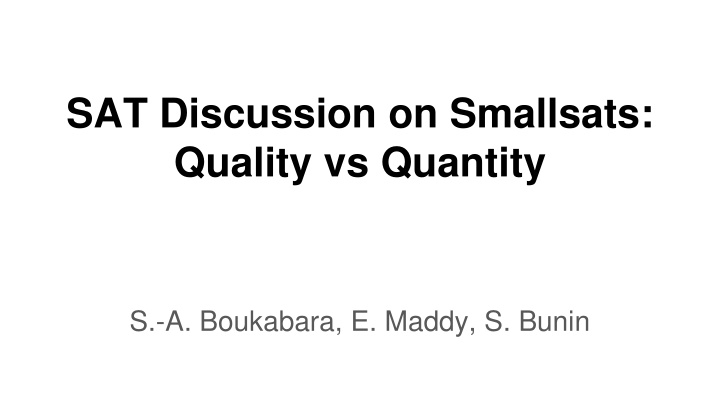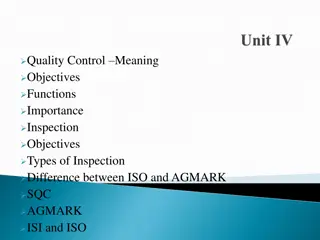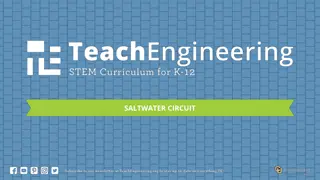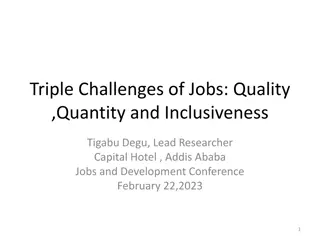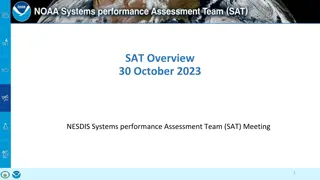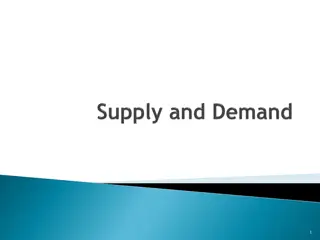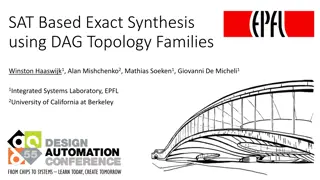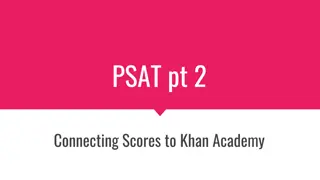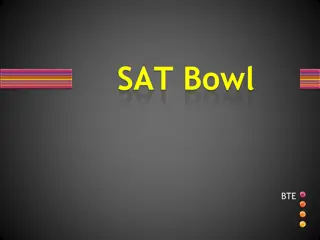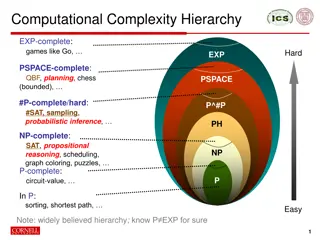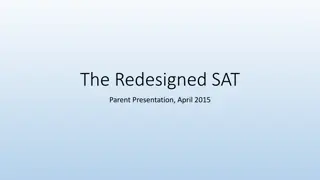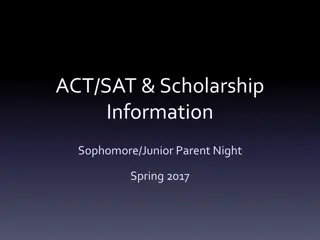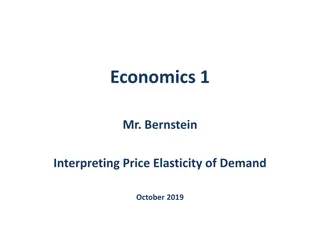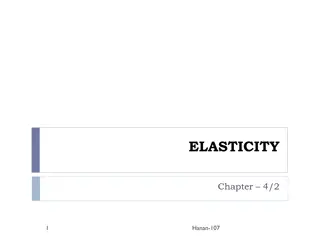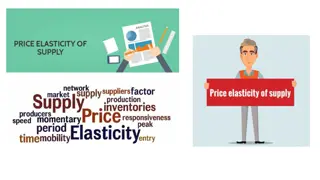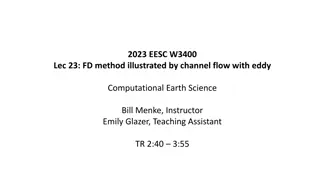SAT Discussion on Smallsats: Quality vs Quantity
Discussion on small satellites focusing on the commitments to WMO's WIGOS 2040 vision, including backbone system configurations, operational pathfinders, and additional capabilities. Explore sounding commitments, CGMS in LEO, and observing system performance attributes.
Download Presentation

Please find below an Image/Link to download the presentation.
The content on the website is provided AS IS for your information and personal use only. It may not be sold, licensed, or shared on other websites without obtaining consent from the author.If you encounter any issues during the download, it is possible that the publisher has removed the file from their server.
You are allowed to download the files provided on this website for personal or commercial use, subject to the condition that they are used lawfully. All files are the property of their respective owners.
The content on the website is provided AS IS for your information and personal use only. It may not be sold, licensed, or shared on other websites without obtaining consent from the author.
E N D
Presentation Transcript
SAT Discussion on Smallsats: Quality vs Quantity S.-A. Boukabara, E. Maddy, S. Bunin
What are Our Sounding Commitments? (to WMO) - WMO WIGOS 2040 vision - Subcomponent 1: Backbone system with specified orbital configuration and measurement approaches - This subcomponent shall provide the basis for Members commitments and should respond to their vital data needs; These are documented in the CGMS baseline (see next slide) - Subcomponent 2: Backbone system with open orbit configuration and flexibility to optimize implementation - This subcomponent shall be the basis for the open contributions of WMO Members and shall respond to target data goals. - Subcomponent 3: Operational pathfinders and technology and science demonstrators - This subcomponent shall respond to research and development needs. - Subcomponent 4: Additional capabilities - This subcomponent shall include additional contributions by WMO Members, as well as from the academic and private sectors. - The division of the observing capabilities into four subcomponents does not imply sequential priorities, that is, it is not expected that all Subcomponent 1 systems will necessarily be realized before elements of other subcomponents are addressed. The main distinction between the various subcomponents is the current level of consensus about the optimal measurement approach, especially the demonstrated maturity of that approach: there is stronger consensus for the capabilities included in Subcomponent 1 compared to those in Subcomponent 2, and so forth. It is likely that the boundaries between the groups will shift over time, for instance, some capabilities currently listed in Subcomponent 2 could transfer to Subcomponent 1.
What are Our Sounding Commitments? CGMS (LEO) - "....LEO may be sun-synchronous or drifting. Sun-synchronous orbits may have Equatorial Crossing Time (ECT) in the early morning (typically, 5:30 and 17:30), the mid-morning (typically, 9:30 and 21:30) or the afternoon (typically, 13:30 and 1:30). They overfly approximatively the same location of the Earth, including high latitudes, at approximatively the same time twice/day. For large-swath instruments, coverage at 4-hour intervals require three satellite at fairly-spaced ECT s. Drifting orbit provide more frequent coverage with decreasing latitude (missing high latitudes) and ensure the viewing of the Earth at changing times of the diurnal cycle. " Sensor Observation/Measurement Attributes Microwave Sounder - Atmospheric temperature, humidity, and precipitation - 3 sun-synchronous orbits, nominally early morning, mid-morning and afternoon Infrared Sounder - Atmospheric temperature, and humidity - Hyperspectral on 3 sun-synchronous orbits, nominally early AM, mid-AM and PM
What is an Observing System Performance? (Main Point: a Sensor accuracy is a subset of the Obs. System Performance) - - Performance is NOT just Accuracy of sensor measurement Performance Attributes: - Information Capability : Depends on sensors characteristics - Spatial coverage : Depend on sensor and constellation characteristics - Temporal coverage : Depends on constellation characteristics - Accuracy - Vertical Resolution : Depends on sensors characteristics - Spatial resolution - Measurement Density : Depends on sensor and constellation characteristics - Vertical validity range : Depends on sensors characteristics - Etc. Applications put different priorities (and requirements) on the performance attributes For example: Global NWP values a lot the capability, accuracy (noise level of radiance), the spatial coverage, temporal coverage, etc Precipitation monitoring, because of strong signal in MW, values spatial and temporal coverage above all (given the POD and FAR metrics used in this application skill assessment) : Dependent on Sensor characteristics : Depends on both sensors and constellation characteristics - - - - For the design & evolution of the space architecture, it is preferable to think about the Observing Systems (sensors in constellation configuration) performance, rather than single sensor accuracy.
Suggested Approach for Performance & Value Assessment (How to Account for Accuracy, Refresh and Costs at the same time in assessing the Observing Systems ability to meet NOAA Requirements) - Step 1: Define performance (SCP) in terms of accuracy, refresh, other attributes (resolution, etc) using Remote sensing Science (information content extraction) and SMEs For Observing System 1: Accuracy Option A, Refresh Rate Option DA , (and options of Spatial resolution) For Observing System 2: . Etc - Step 2: Compute cost based on formula (assuming observing system is composed of N satellites, each with a number M of similar sets of sensors Sensor_j (j=1,M) on each of the satellite_i (i=1,N), - Step 3: Use ASPEN with SCP inputs and Cost estimates above. Assess using the Global NWP ref
Questions for SAT What are the global NWP requirements in 2030-2040 and technical weights? (see table) - Observable Weights Observable Precision/Accuracy (std) weight Observable Refresh rate weight Std/Accuracy Requirement Range Refresh Requirement Range Temperature (K) 1 1 0.5 [2.5,2,1.5 1] [4h, 2h, 1h] Moisture (%) 0.5 1 0.5 [24,16,8] [4h, 2h, 1h] - - How important we have 100% coverage, can we tolerate orbital gaps?, how much? 90% is ok? If we have to make compromises on the sensor design itself (to save cost, to add spatial coverage, and temporal refresh, etc) what could be downgraded: channels, noise levels, spatial resolution, vertical resolution, etc? Thoughts about the approach suggested (using ASPEN) on proposing the different technology solutions ? Quality vs Quantity and optimal Observing Systems: For IR, are two orbits of a CrIS-class sounder (0930/1330) better than six or twelve orbits of disaggregated SW/MW and LW/MW sounders that increase temporal and spatial coverage? For Microwave, are two orbits of ATMS-class sounder preferable to 6 or 12 orbits of smallsats-type MW Sensors with significantly improved refresh rate (and seemingly ATMS-equivalent sounding accuracy)? What is ideal sounding capability of the future? (cost-effective smallsats/cubesats swarm of capable sounders, JPSS-style constellation with ATMS/CrIS sounders but one orbit only, Hybrid approach of both...) - - - -
Sensors MW Precision Overall Assessment (Moving to High Freqs and Lower Noise) Temperature performance wrt ATMS Moisture performance wrt ATMS TRL Added Benefits Approximate Cost comparison wrt A A: ATMS Baseline channels, ATMS noise levels TPW, RR, SWE, SIC, Cloud, etc Cost-A B: A with Improved Noise (0.25K for 50GHz, 0.35K for the 183GHz) Cost-B = fraction of Cost-A Improvement relative to baselines is mostly due to improved noise C: A plus 118GHz and 204 w Improved Noise (0.25K for 50GHz, 0.35K for the 183GHz 0.3K for 118GHz) Cost-C = fraction of Cost-A D: A plus 118 and 204 but w Real Noise levels from ATMS, MicroMAS-2 Cost-D = fraction of Cost-A F similar to E, a little worse in middle troposphere, but better in stratosphere Cost-E = fraction of Cost-A Small bump/degradation in middle/lower troposphere without low freq. E: A minus 23, 31 but plus 118 and 204, w Improved Noise (0.25K for 50GHz, 0.35K for 183GHz 0.3K for 118GHz) F: A but 50GHz replaced by 118 and w 204GHz and Improved Noise ( 0.35K for the 183GHz 0.3K for 118GHz) Cost-F = fraction of Cost-A Slight degradation in the stratosphere G: TEMPEST (only WV channels) Cost-G = fraction of Cost-A Significantly higher (>15%) Higher (5-15%) Equivalent (within 5%) Lower (5-15%) Significantly Lower (>15%)
